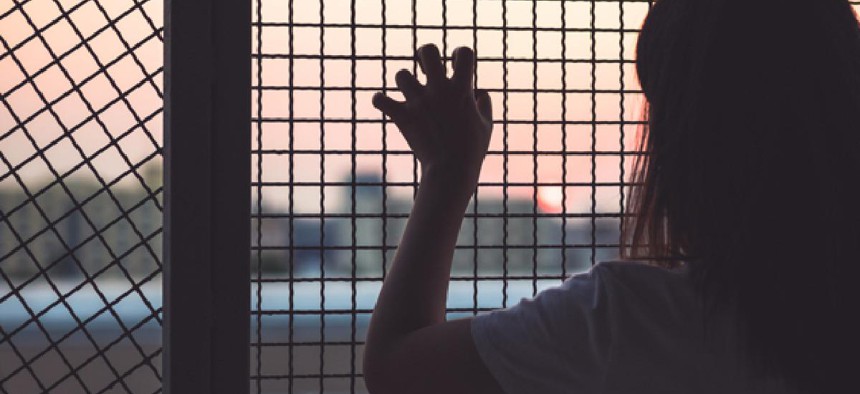Gender matters when we talk about reforming Rikers

Photo: Structuresxx/Shutterstock
With the welcome news that the jail complex on Rikers Island is now headed for eventual closure, there is an opportunity to think more deeply about the people who end up there. The number of women in the American justice system increased by more than 700 percent from 1980 to 2014 – yet women lackvisibility. On any given day 600 women are jailed at Rikers Island, yet they are absent from the larger narrative about incarceration.
From an inherently biased bail process to uniforms designed to fit men’s larger frames, the system fails to consider that when it comes to incarceration, gender matters.
“Women InJustice: Gender and the Pathway to Jail in New York City,” a report from the Prisoner Reentry Institute at John Jay College of Criminal Justice and commissioned by The New York Women’s Foundation, looks at the factors leading to the incarceration of women at Rikers. It is a companion piece to the Rikers report from the Independent Commission on New York City Criminal Justice and Incarceration Reform and addresses the overuse of jail within a system largely indifferent to how a one-size-fits-all approach has served women so poorly.
Data about incarcerated women is too often overshadowed by the much larger data set on incarcerated males, who comprised more than 80 percent of all arrests in 2014. Analysis of incarceration, with an intentional focus on representing the jail system from a woman’s point of view, is rare and desperately needed.
Too many women are jailed in Rikers and subjected to the senseless harms of incarceration, when they could simply be diverted to services in the community. In 2014, some 6,745 women were held at Rikers and 80 percent were in pretrial detention, or jailed while their cases were pending. Most women are in jail for very short periods of time – 50 percent are released within a week and another 10 percent are released in two weeks. The single most important factor driving their admission is their inability to pay bail. Just 38 percent of women interviewed at arraignments in 2014 in New York City reported being employed, compared to 46 percent of men. Yet the system fails to consider that many women are often unemployed single mothers. Securing cash bail at the courthouse is impossible for them. In 2014, only 8 percent of women could make this payment. The others were sent to Rikers, where 44 percent make bail at some point. The rest remained at Rikers until their cases were finished.
These short, meaningless jail stays can have a disastrous ripple effect on women and their families.
Two weeks behind bars disrupts child care, sometimes forcing children into foster care, or at minimum, resulting in missed school days and trauma from being separated from a parent. It can mean losing an apartment and disrupts employment and education commitments. Jail is also disruptive to community treatment of mental health needs. Not to mention specific harms that can accrue for women during even a short stay: The rate of sexual assault is higher at the Rikers women’s building than other areas of the complex.
Even before reaching jail, trauma and distress frequently mark the lives of women who end up there. Most report extensive histories of physical, sexual and emotional abuse, often starting when they were children. They are typically abused by people close to them, and they are more likely to be introduced to illegal activities by the people who are close to them. Between 77 percent and 90 percent of women in jail have experienced intimate partner violence.
Victimization and trauma can lead to depression and other mental health disorders. Incarcerated women report symptoms of a mental illness at rates that are five to six times higher than women in the general population. Often, these kinds of illnesses lead to self-medicating behavior by abusing drugs, another pathway to arrest and incarceration.
Three-quarters of women are charged with misdemeanors. Assault is a common charge, which must be understood in context: For abused women, a lasting consequence of trauma can be difficulty coping during conflicts that trigger past abusive experiences. Shoplifting and other theft offenses are also common for women. These must also be considered within the context of economic marginalization, poverty and the stress of being a primary caregiver.
We must do more to eliminate unnecessary incarceration. Women with mental health needs should be diverted to social services, not arrested. We also must end the use of jail for misdemeanors such as shoplifting, drug possession, prostitution or minor fights when there are effective alternatives for holding women accountable and preventing them from recidivating.
Reforming bail is also key to reducing the number of women who are jailed. We should increase the use of nonmonetary forms of bail and supervise more women in the community while their cases are pending to help keep families together and avoid disruption to employment, education and housing.
Our criminal justice system should provide gender-specific and trauma-informed programming to address root causes that lead women to the justice system, and ensure that women are connected to appropriate social services.
Focusing on women in the criminal justice system does not mean that the system is effectivelymeeting the needs of men – it is not. Rather, by focusing on the needs of women, we can ultimately inspire attention to the needs of men as well and move toward a system that treats all people with dignity.
Ana Oliveira is president and CEO of The New York Women’s Foundation, and member of Independent Commission on New York City Criminal Justice and Incarceration Reform. Alison Wilkey is director of public policy at the Prisoner Reentry Institute at the John Jay College of Criminal Justice.
